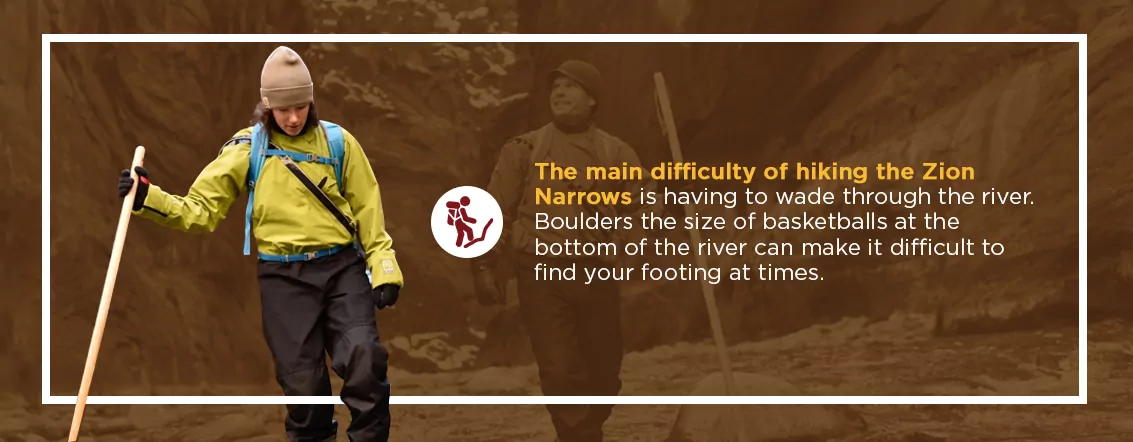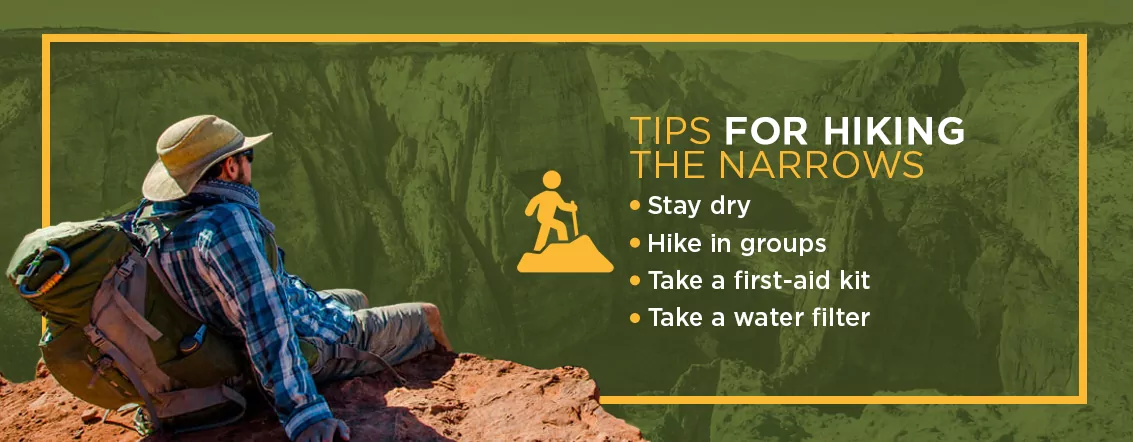Zion Narrows Hike: Everything You Need to Know
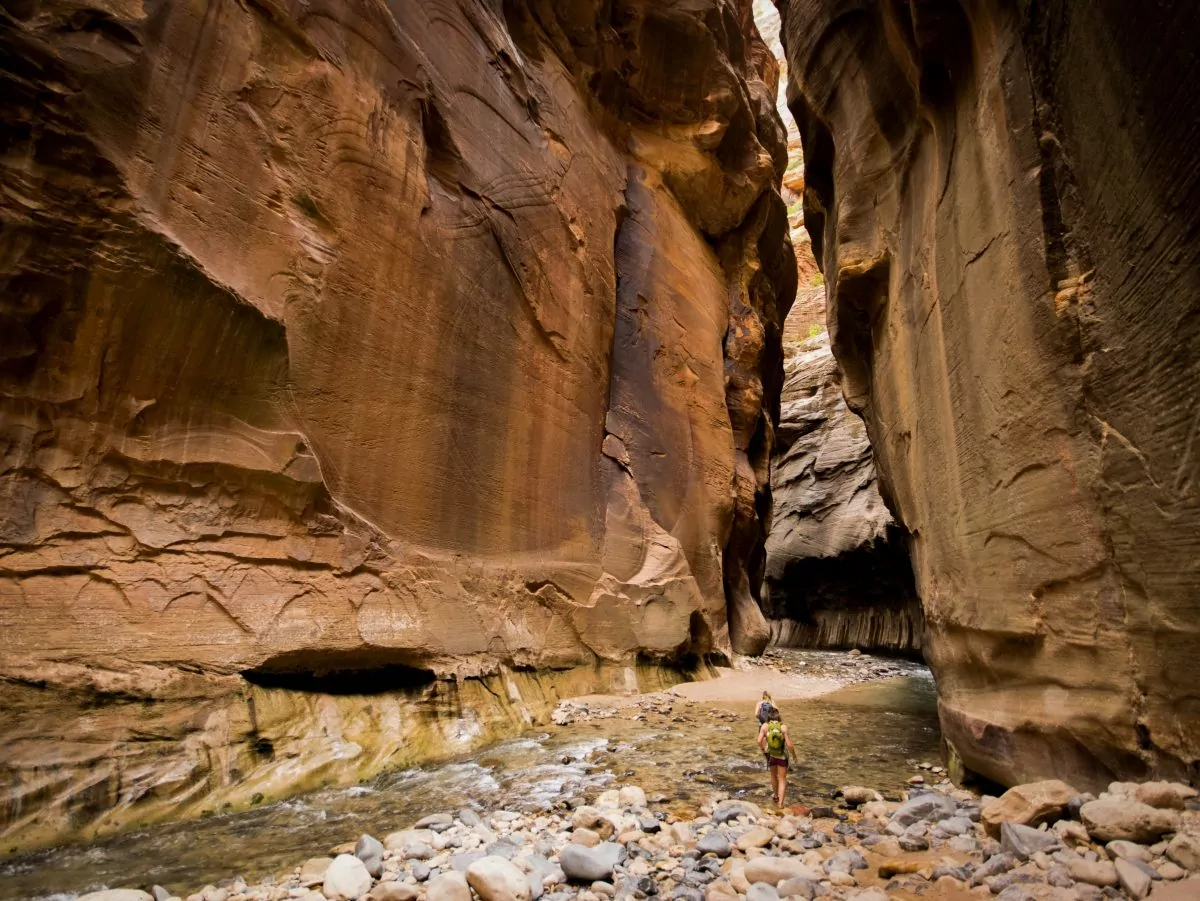
The Zion Narrows is a tall, narrow gorge carved out by the North Fork of the Virgin River. As one of Zion National Park’s most popular hikes, it is a bucket-list destination for outdoor enthusiasts worldwide. If you’re looking for a hiking route that will amaze you, challenge you, and heighten your appreciation for the Southwest’s natural beauty, the Narrows is an excellent choice.
Because most of the Narrows hike takes place in the river, it presents a unique set of challenges. In this guide we will help you prepare for these challenges to make sure your Zion Narrows adventure is as safe and enjoyable as possible. Whether you’re looking for information on hiking permits, how to prepare, when to visit, or what guided options exist – we’ve got all the details you need.
Award Winning Utah Hiking Vacations
What Makes the Narrows Special?
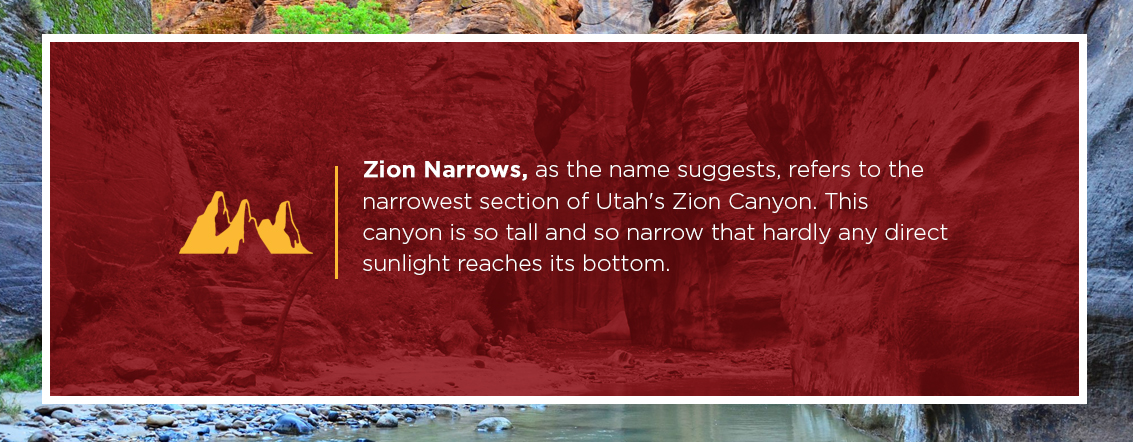
The Narrows, as the name suggests, refers to the narrowest section of Utah’s Zion Canyon. This canyon is so tall and so narrow that hardly any direct sunlight reaches its bottom. It is considered one of the best — if not the best — slot canyon hikes in the world. The Virgin River itself becomes your trail as you trek through this narrow sandstone canyon with walls hundreds of feet high on either side.
Because the Narrows is a hike like no other, it requires you to think about several things that you don’t have to worry about on other hikes, like permits, special equipment, water flow rates, the potential for flash floods, and the difficulty of walking through a river for hours on end. We will address all of these in the following sections to help you feel prepared and informed for your hike.
Zion Narrows: Top-Down or Bottom-Up?
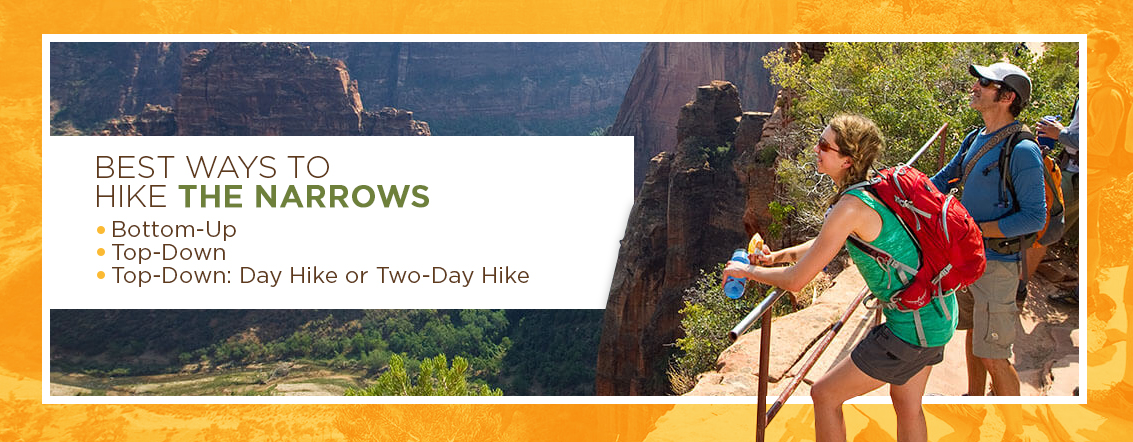
There are a few different ways to hike the Narrows. The option you select will depend on your hiking preferences, experience, and time availability.
BOTTOM-UP
If you’re a casual hiker who wants to see the best the Narrows has to offer, consider starting your hike from the Temple of Sinawava, the final stop on the Zion Canyon shuttle. From here, you can travel up the Riverside Walk trail and wade on into the water to take in some of the Virgin River’s best “narrows” segments. You can hike up the river as far as Big Spring, roughly 9 and a half miles round trip, without a permit.
From this direction you will have the chance to see many of the most famous sights in the Narrows. Mystery Falls is less than half a mile from the Temple of Sinawava, while the iconic Wall Street section requires a roughly 6 mile round trip hike. If you have the energy and time for more canyon scenery, you can also take a short detour up Orderville Canyon, branching off of the North Fork to the East.
TOP-DOWN: DAY HIKE
Hiking the Narrows from the top down is considerably more strenuous. It’s a challenging 16-mile hike beginning at Chamberlain’s Ranch, a remote location that you can only access by driving there yourself or by hiring a private outfitter.
If you’re a strong, fast hiker looking for a challenge, you can complete the hike in one day — just make sure to get an early start and maintain a steady pace. In case the sun goes down before you finish your hike, bring a headlamp along.
If you choose this direction, you will get to experience the North Fork’s gradual transformation from open river to deep slot canyon. To hike this route, you will need to obtain a wilderness permit.
TOP-DOWN: OVERNIGHT HIKE
The top-down hike takes approximately 12 to 14 hours to finish. If you would prefer to take things at a more leisurely pace, we recommend that you camp overnight and complete the hike over two days. This is the more popular option. You’ll need to obtain a wilderness permit to complete this overnight hike. When buying this permit at the Visitor Center, you will also pick out one of the park’s designated campsites.
All-inclusive USA Hiking Adventures
Best Times of Year to Hike the Zion Narrows
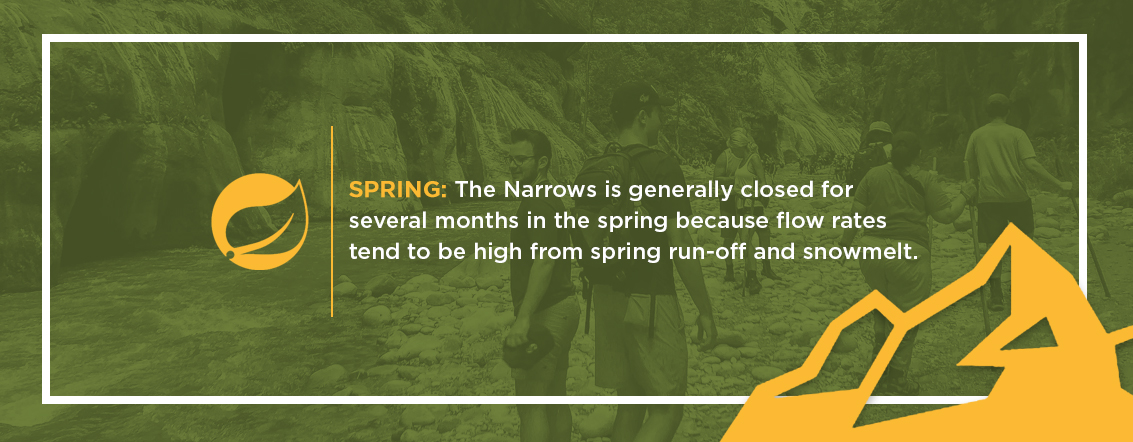
As long as it’s open, you can hike the Narrows any time of year, but each season brings its own challenges that hikers should be prepared for. Below, we give you an idea of what you can expect during each season so that you can pick the one that is best for you.
Spring
The Narrows is generally closed for several months in the spring because flow rates tend to be high from spring run-off and snowmelt. This closed period is generally between mid-March and mid-May, although it varies from year to year depending on the weather. If the flow rate exceeds 150 CFS, the National Park Service won’t issue permits.
Summer
Summer is an ideal season to visit the Narrows. The air and water temperatures are warm and the days are long. Shuttles run until around 9 p.m., giving you plenty of time to complete the top-down hike in one day. However, keep in mind that summer is the most popular season. The Narrows could be crowded, so you can expect to share the trail with many other hikers — particularly between Riverside Walk and Big Springs. Also, keep in mind that summer is the most difficult season to obtain a permit and flash flooding is more likely due to the annual monsoon season.
Fall
Autumn is also a great time to hike in the Narrows. It’s less crowded than the summer, the fall colors are starting to come out, and if you visit in the early fall, the weather is still quite pleasant. If you come later into fall, you’ll have fewer daylight hours and the temperatures may be a bit less comfortable. The park’s shuttle service also runs fewer hours during this season, which may cut your hike short.
Winter
Hiking the Narrows in winter is cold, but it’s often the best time to avoid crowds. If you plan to hike the Narrows in winter, be prepared for limited daylight hours and frigid temperatures. Also, the park shuttle does not run regularly in the winter and the road leading to Chamberlain’s Ranch may be closed due to snow. The National Park Service doesn’t issue permits for a single day top-down hike due to the insufficient amount of daylight to hike it. Be sure to plan carefully for the winter conditions so your hike is still safe and enjoyable.
Other Seasonal Considerations When Hiking the Narrows
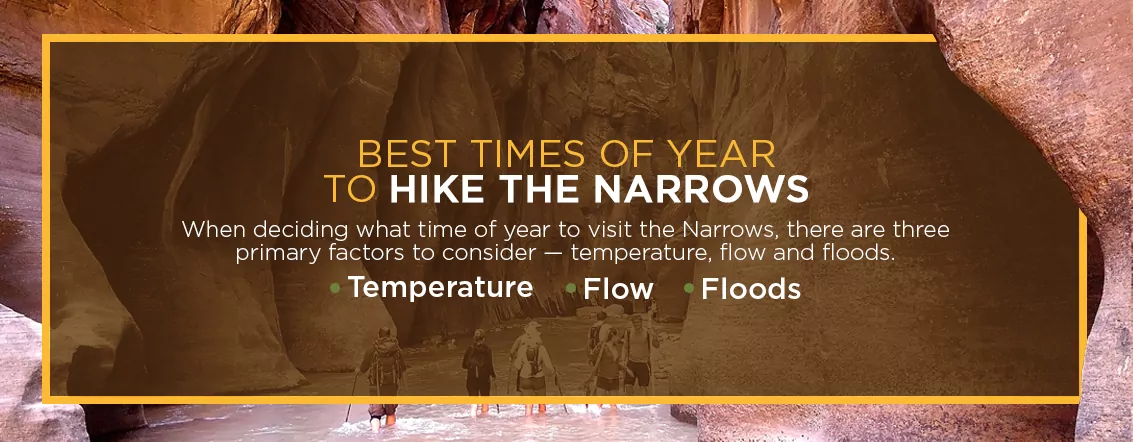
There are a few other considerations regarding weather and the seasons that you will need to take into account when deciding what time of year to visit the Narrows. The three primary factors to consider are temperature, flow and water level, and floods.
TEMPERATURE
In some ways, the temperature is actually the least important factor to consider as you choose when to hike the Zion Narrows. Water flow permitting, the Narrows is open all year round.
If you chose to hike the Narrows when it’s cold (late fall, winter, or early spring), it’s important to have the right gear to prevent hypothermia and other ill effects due to cold. Depending on the immediate conditions, this could mean a full dry suit or a simple pair of river sandals. In the early spring, groups often hike in dry pants. Late-spring and late-fall groups typically hike in neoprene “wet suit” pants. Wildland Trekking provides temperature-appropriate river hiking gear for every Narrows trip, during every time of year.
All Wildland groups typically wear specially provided canyoneering shoes with neoprene socks. The exception is during those hot summer months when it’s simply nice to hike in river sandals. However, we only recommend this when the water level is very low.
Flow and Water Level
How high the water is and how fast it is moving will determine whether the Narrows feels more like hiking through a stream or canyoneering in a fast moving river gorge. The National Park Service closes the Narrows whenever the water flow is above 150 cubic feet per second (CFS). It’s worth noting here that this metric is about how fast the water is moving, not how deep it is. Historically, the water level has been lowest in the fall and highest in the spring when the snowmelt and rainfall flow into the canyon.
If you book a Wildland Zion tour (extend this link to begin with the word “book” for action clause) from mid-March to early-May, you should be aware that the Narrows could be closed. However, your spring trip will still be worthwhile, as we have many wonderful alternate hikes available. But if the Narrows are on your bucket list, your best bet is to book for the fall. You can check the U.S. Geological Survey or check current conditions (link to https://www.nps.gov/zion/planyourvisit/conditions.htm) for a sense of what the water levels will be.
FLOODS
Of all the dangers in the Narrows, flash floods are your biggest threat. Because it is a “slot canyon” with high walls on either side, the Narrows is prone to flash flood conditions where water levels rise suddenly and strong currents carry debris through the water. Deaths have occurred in the park from flash flooding as recently as 2022.
These weather events can occur at any time of year. Fall has the least risk of flash flooding as it has the lowest rainfall. Spring brings desert wildflowers along with a greater chance of rain showers, snowmelt, and flash floods. Summer brings the North American monsoon season, which can bring on rapid afternoon rainstorms.
Because a 344-square-mile watershed feeds into the Virgin River Narrows, it only takes a few drops of rain to create a flash flood, all funneling into the canyon. Unless there is an official Flash Flood Warning from the National Weather Service — meaning that a flash flood is imminent — the Park does not typically close the Narrows for flash flood danger. But flash floods can happen at any time, and guided trips are sometimes canceled if there is significant flash flood danger. If you’re traveling without a guide, you should avoid the Narrows during high risk periods.
Toxic Cyanobacteria Bloom
At time of writing, the Virgin River is experiencing a bloom of toxic cyanobacteria that makes swimming and recreating in the river unwise. This toxin can cause illness or death if contracted through drinking or through another opening in the skin (such as eyes, ears, or nose). While the Narrows is still open, hikers should not drink the water as no commercial filtration system is known to effectively remove the toxin. It is also important to keep children and dogs away from the water as recklessness and ignorance can cause them to contract the toxin more easily. You can check the national park website for current updates on cyanobacteria.
Zion Narrows Hiking Permits
Whether or not you need a permit to hike the Narrows trail will depend on the direction you plan to hike. If you plan to do the bottom-up hike starting at the Temple of Sinawava and turning around before Big Spring, a permit is not necessary. However, if you choose the top-down hike, whether in one day or over two days, a permit is required. You can visit the National Park Service’s site to find out more about day-hike and overnight reservations.
If you plan to do the Narrows hike in a single day, but no advanced reservations are available, don’t panic — the park will open their “Last Minute Drawing” two to seven days before the desired date for your trip. If there are still available spaces after this drawing, they’ll become available for walk-in, which you can obtain the day before your trip starts. However, these spaces are limited (and popular), so be sure to show up to the permitting office early if you want to snag a walk-up permit.
If you would like to go backpacking in the Zion Narrows, you’ll need to get a backcountry campsite permit. The Narrows gorge has a dozen campsites which have a range of capacities, the lowest being four hikers and the highest being twelve. The campsites also vary in how you can reserve them. For the six campsites that can only be reserved with a walk-in permit, you can obtain the permit the day before your hiking trip between 10 a.m. and 5 p.m. You can check out all the Narrows campsites on the NPS website.
If you book a tour with Wildland Trekking that includes the Zion Narrows hike, we will take care of permits for you so you won’t have to go through the process yourself.
How to Prepare for Your Narrows Hike
In this section we’ll discuss how to hike the Narrows, what you can expect, and what to bring. The Narrows is no simple hike and includes elements of canyoneering that few other hikes do. If you do a bottom-up day hike and start at the Temple of Sinawava, most people can make it to Mystery Falls less than half a mile from where the trail enters the river. However, if you want to get that slot canyon feeling, but don’t want to get wet, you can always turn around at the end of the Riverside Walk Trail. If you’re set on getting the full experience hiking in the Virgin River, there are a few dangers and difficulties—as well as tips and tricks— that you should know.
ZION NARROWS HIKE DIFFICULTY
The main difficulty of hiking the Zion Narrows is having to wade through the river. Boulders the size of basketballs at the bottom of the river can make it difficult to find your footing at times. Because you walk in the river for much of the hike, this can be quite taxing on your body. Be prepared to fall, trip, and stumble as you make your way across. It’s all part of the experience!
Naturally, the higher the water is, the more difficult it will be to traverse. You can read up on what water levels are typical (link back to seasonal section), but you should be prepared for anything from knee-deep to thigh-deep wading, sometimes even swimming if you’re visiting in spring. Flash floods can occur when the water is at any level, at any time of year, so you should check the national weather service for flash flood warnings as well as checking the standard water level.
When hiking up the river, it’s important to be aware that there isn’t an “out” except the trailhead. If you begin to get tired and decide to bail, you’ll have to hike back the way you came in.
EQUIPMENT
Having the right equipment is a must when hiking the Narrows and can not only be the difference between having fun and being miserable, but also the difference between safety and severe danger. Below is a list of items you’ll want to bring with you on your Narrows hike. While some of them are general hiking necessities, others are specific to this unique hike.
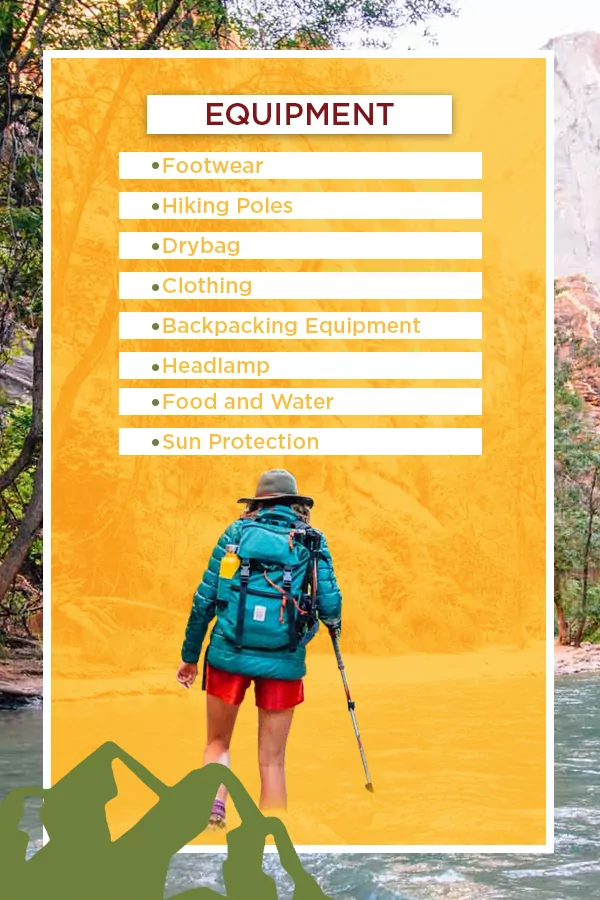
FOOTWEAR
When hiking the Narrows, you’ll walk through water up to your knees for almost the entire time. Accordingly, you’ll need durable, water-friendly footwear that has toe protection. We recommend trail runners without GORE-TEX, so they can drain and breathe. For socks, we recommend a high-quality pair made of neoprene, which helps your feet stay blister-free and warm during your hike. While this is a hike and not technically canyoneering, it’s helpful to think of it as canyoneering when choosing your footwear.
Avoid bringing footwear like light sandals or water shoes. They will most likely break before the day has ended and, if your toes aren’t covered, the rocks in the river may injure your feet. You should also refrain from wearing bulky hiking boots. While they offer great protection for your feet, they will most likely take a long time to dry and will end up smelling foul.
HIKING POLES
Since you’ll be hiking through water for most of the day and the river current is quite strong in places, having trekking poles or a hiking stick will help you maintain your balance. If you have only one hiking stick, use it on the upstream side to make it easier to balance.
DRYBAG
Chances are you’ll have some belongings you won’t want to get wet, such as your camera, phone, and wallet. You can stow these items in a drybag. Although the Narrows hike is mostly knee or waist deep, you will encounter a few sections where you’ll be submerged up to your chest — and you might even have to swim!
CLOTHING
Only bring clothing items that you don’t mind getting wet. Non-cotton layers are recommended, as they will dry the quickest. Because you won’t be getting too much direct sunlight, bringing along a fleece is a great way to stay warm. If you’re visiting during the cold months between October and April, water temperatures can drop down to 40 or even 30 degrees, so wearing a wetsuit or drysuit is a good idea.
BACKPACKING EQUIPMENT
If you’re opting for the top-down backpacking hike, you’ll need to bring along some standard overnight equipment. This includes a small tent, sleeping bag, portable stove, and drybags to store all of this equipment. You should also be aware that campfires are prohibited in the Zion National Park backcountry, so make sure to leave your campfire gear behind.
HEADLAMP
There’s always a chance you could get stuck on the trail after sundown, so don’t forget to bring a headlamp. If you don’t have this useful piece of equipment, hiking the trail will be impossible once the sky is completely dark. Bringing a headlamp is especially important if you’re trying to complete the top-down hike in a single day. When shopping for a headlamp, look for models that are lightweight and waterproof.
FOOD AND WATER
You should bring along a minimum of three liters of water. The Zion Narrows hike can be extremely strenuous, and you will probably be on the trail for most or all of the day. This makes it critical to stay hydrated.
The food you bring should provide lots of energy but not make you feel sluggish or heavy. Aim to bring food rich in carbohydrates, protein, and electrolytes. We also recommend bringing along some salty foods to replenish the salt lost through sweating.
SUN PROTECTION
Even though the tall, narrow canyon will block much of the sun, you will still be exposed to direct sunlight in certain sections. We recommend bringing a long-sleeved sun shirt, sunscreen, a hat, and lip balm.
Tips for Hiking the Narrows
TIPS FOR HIKING THE NARROWS (Section heading)
In addition to the advice above, here are some extra tips to make your Narrows excursion safer and more comfortable:
- Stay Dry: You’ll be partially submerged in the water for much of the hike, so you’ll want to keep yourself and your belongings as dry as possible. Wear non-cotton layers, which will dry more quickly. Bring them in a waterproof backpack or a drybag for your belongings.
- Hike in Groups: You should travel in groups of three people or more, which will allow someone to seek help if there’s an emergency.
- Take a first-aid kit: In the remote wilderness, it is essential to have the equipment to treat injuries. Make sure it has bandages for minor scrapes and scratches, antiseptic wipes, mild pain relief, and anything else you might need. If you are opting to do the backpacking trip and have personal medication, bring a duplicate and have another person carry it in case one gets wet and is unusable.
- Don’t Drink the Water: Due to increasing temperatures and dry conditions, cyanobacteria has flourished in Zion National Park. The NPS has issued a warning about the toxic cyanobacteria and advised visitors against drinking any stream water in the Park.
Narrows Alternative: The Subway
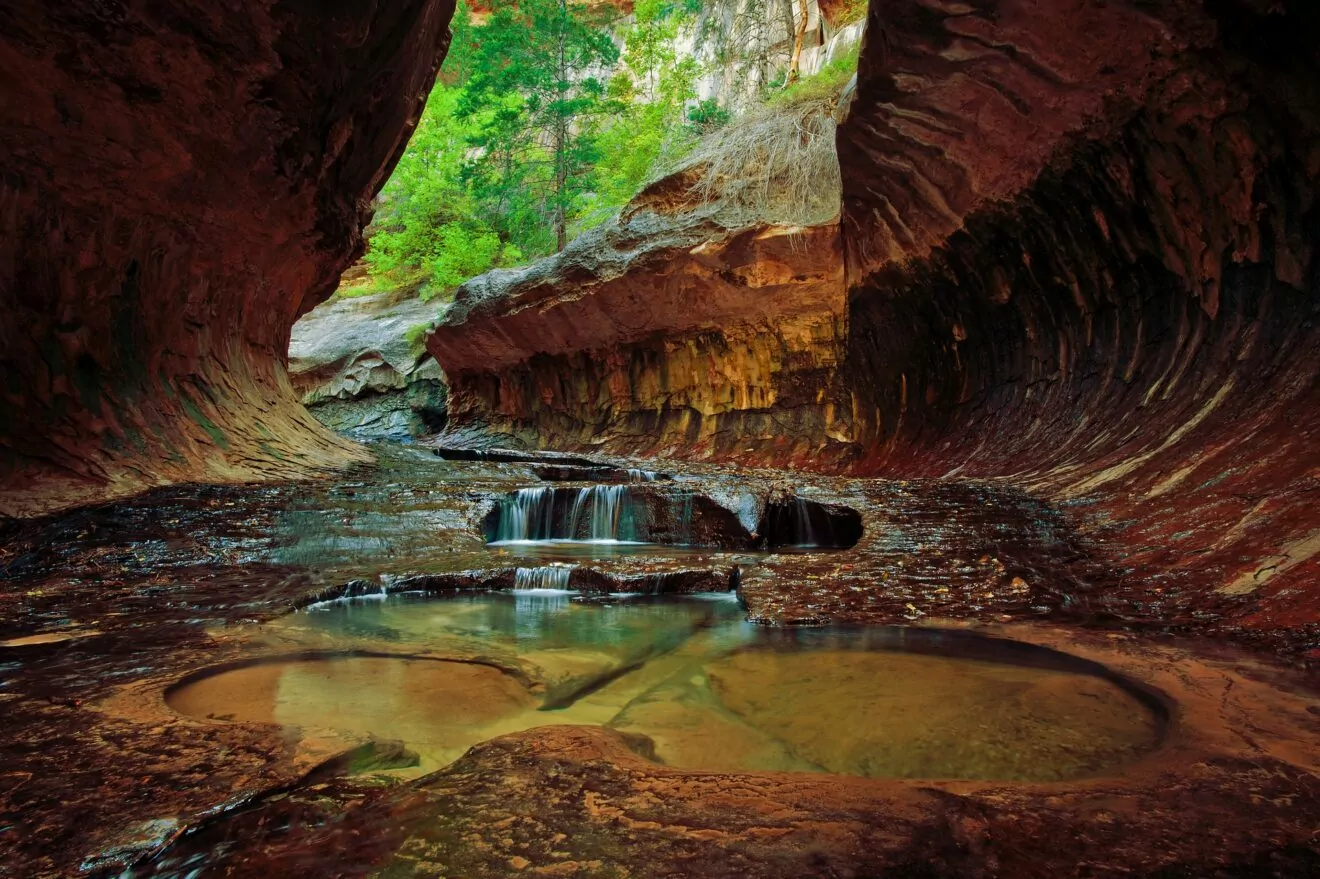
The Narrows are perhaps Zion’s most iconic hike, but many have heard of another canyon hike that Zion has made famous: the Subway. This trail, actually the Left Fork of North Creek, is much more strenuous than the Narrows and involves true canyoneering with rappelling, route finding, rock scrambling, and permits all required. There are two ways to hike the Subway, both of them begin and end on the Kolob Terrace Road (open to vehicles year round, weather permitting). This trail is much less accessible than the Narrows because both versions of it are so strenuous, but for those who are capable, the Subway is a fantastic way to immerse yourself in the wilderness and escape some of the crowds.
Difficulty and Dangers of the Subway
The Subway comes with significantly more danger than the Narrows due to its technical, canyoneering elements. Both versions of the Subway (top-down and bottom-up) involve extensive route finding in which hikers will have to use a map, compass, and route description in order to avoid becoming lost. The bottom-up route is a very strenuous 9-mile loop that begins and ends at Left Fork Trailhead. In addition to route-finding, this route also involves hiking in ankle to knee-deep water and scrambling over large boulders.
The top-down route of the Subway is a 9.5 mile, very strenuous, point to point hike beginning at Wildcat Canyon Trailhead and ending at Left Fork Trailhead, both on Kolob Terrace Road. This route involves rappelling skills, 60ft of rope, extensive route-finding experience, and swimming through several very deep, cold pools filled with debris.
Both routes through this canyon are prone to flash flooding much like the Narrows, so make sure to check flash flood warnings and the weather. Because of the difficult terrain, extreme caution should be taken while hiking the Subway. If you’re not sure if you have the experience to do the hike, you probably don’t. There are no guided trips to the Subway and all hikers must abide by the canyoneering regulations of the National Park.
Permits and Logistics
Despite being a day-use only area, all hikers must have a permit to enter the Subway. This is due to its popularity as well as to control crowding that could become dangerous. The main lottery for permits is open two months in advance of your trip. If any spaces remain available after the advanced lottery, they can be reserved through the Canyoneering Calendar Reservation System. There is also a last minute permit drawing 7-2 days in advance of your intended trip, but we don’t advise relying on these last minute permits as they go quickly.
Group sizes are strictly enforced, with the maximum being 12 and the minimum being 2. You can visit the national park website to learn more about permits and the Subway in general.
Hike the Narrows With Wildland Trekking
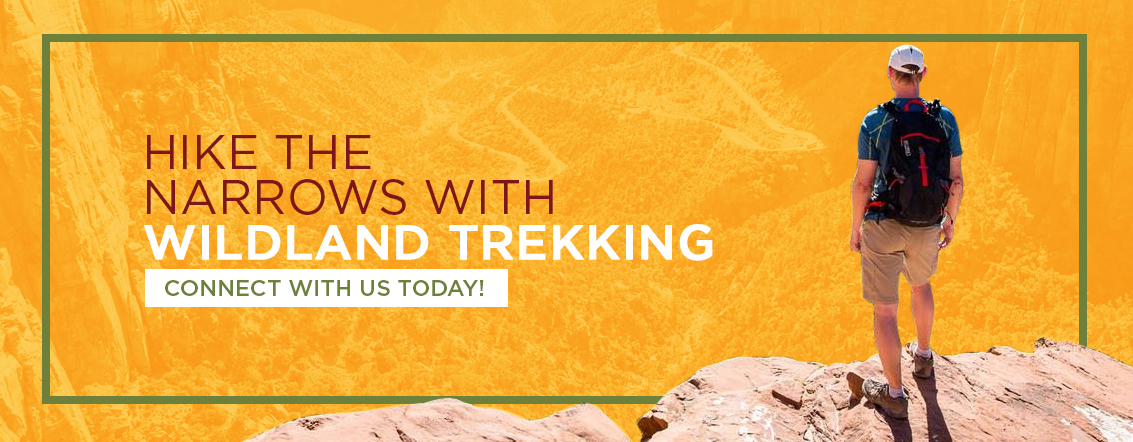
As you plan your trip to Zion and consider hiking the Narrows, it is worth exploring whether you will get the most out of visiting the park on your own or as part of a guided excursion. Hiking on your own allows more flexibility and ownership, but comes with logistical concerns and an added weight of responsibility. Especially if it’s your first time visiting Zion or hiking the Narrows, having an experienced guide can make all the difference in enjoying your hike safely and without stress.
At Wildland Trekking, we offer a variety of hiking tours in the national parks of Southern Utah. Many of these tours combine Zion with highlights from other nearby parks, like the Grand Canyon and Bryce Canyon. We lead both inn-based and camping-based trips, allowing you to enjoy the Narrows and the greatest attractions of Utah’s Canyon Country from your choice of comfortable accommodations.
If you have less time and want to get the most out of your experience, join us for one of our Zion Day Hike Tours. These tours are designed to maximize your day in the park with a guided hiking tour on one of Zion’s best trails. Regardless of your preferences, Wildland Trekking has an all-inclusive option for you.




